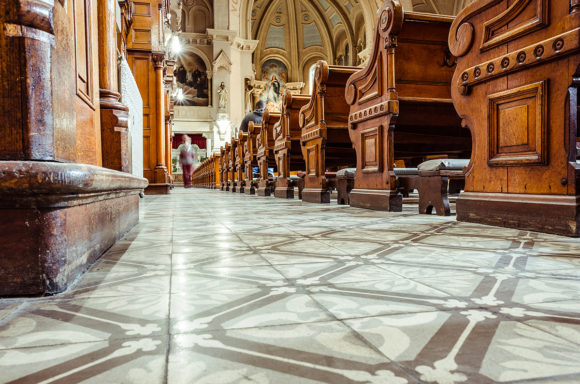Maryland Attorney General Anthony G. Brown has released his agency’s report documenting a long history of widespread child sex abuse and systemic cover-up by clergy and others associated with the Archdiocese of Baltimore.
The redacted Report on Child Sexual Abuse in the Archdiocese of Baltimore is the result of a four-year investigation into 60 years of allegations of child sexual abuse by members of the clergy and of the cover-up of that abuse by the leadership of the Catholic Church.
According to the report, young people in some parishes were preyed upon by multiple abusers over decades, and “clergy used the power and authority of the ministry to exploit the trust of the children and families in their charge.”
The report describes the repeated actions of church leaders to conceal and cover up the abuse, moving priests to other parishes, failing to investigate or report abuse to civilian law enforcement authorities, and providing financial support to priests in retirement.
“This report illustrates the depraved, systemic failure of the Archdiocese to protect the most vulnerable – the children it was charged to keep safe,” said Brown.
“Time and again, the Archdiocese chose to safeguard the institution and avoid scandal instead of protecting the children in its care. This Report shines a light on this overwhelming tragedy, and it was the courage of the survivors that made it possible.”
The report recommends that Maryland eliminate the statute of limitations that has prevented survivors from bringing civil actions against abusers and recovering damages for the harms they have suffered. The General Assembly is currently considering a bill to do that titled the Child Victims Act of 2023. Currently, people in Maryland who say they were sexually abused as children can’t sue after they reach the age of 38.
The Maryland Catholic Conference, which represents the three dioceses serving the state, opposes the bill, contending it’s unconstitutional.
Baltimore Circuit Court Judge Robert Taylor ruled in February that a redacted version should be made public. Taylor said at the time that releasing the report was important partly because the “only form of justice that may now be available is a public reckoning.”
Per order of the court, the attorney general has redacted the names and identifying information of persons named who are living, and who the report accuses of “hiding abuse, enabling abuse, assisting in the cover-up of abuse, or protecting abusers from the consequences of their action.” People whose identities are redacted will be given an opportunity to file objections with the court before the court will decide whether to permit another release without redactions.
Included in the report are 156 current or former Catholic clergy, seminarians, deacons, members of Catholic religious orders, teachers at Catholic schools, and other employees of the Archdiocese known to have been the subject of credible allegations of child sexual abuse committed in the Archdiocese of Baltimore or to have relocated to the Archdiocese in the wake of child sexual abuse committed in other dioceses.
The report also identifies 43 other clergy who served in some capacity or resided within the Archdiocese but who committed sexual abuse outside the Archdiocese of Baltimore.
The investigation was launched in 2018. A grand jury issued subpoenas to the Archdiocese of Baltimore, as well as to individual parishes, religious orders, and St. Mary’s Seminary. Hundreds of thousands of documents dating back to the 1940s were produced over a four-year period, including treatment reports, personnel records, transfer reports, and policies and procedures.
The attorneys and investigators interviewed hundreds of survivors and their family members, and other witnesses. An email address and telephone hotline received tips from over 300 people, including survivors and witnesses.
Archdiocese Response
Archbishop William E. Lori of the Baltimore Archdiocese acknowledged that the crimes were committed. He called the report a “sad and painful reminder of the tremendous harm caused to innocent children and young people by some ministers of the Church. The detailed accounts of abuse are shocking and soul searing. It is difficult for most to imagine that such evil acts could have actually occurred. For victim-survivors everywhere, they know the hard truth: These evil acts did occur.”
Lori maintained that the church has learned from the tragedy and began making changes in the 1990s to end the scourge. “The Archdiocese is not the same organization it was then,” he stated, noting that the report shows that cases of abuse peaked during the 1960s and 1970s and instances have fallen every year since then, along with the development of Archdiocesan policies designed to protect children.
“Make no mistake, however: today’s strong record of protection and transparency does not excuse past failings that have led to the lasting spiritual, psychological and emotional harm victim-survivors have endured,” he wrote in a statement on his blog.
But survivors of the abuse insist there is more Lori and the church should do.
“These are astonishing numbers that demand immediate reform within the Catholic Church in the U.S. and worldwide,” commented the Maryland chapter of the Survivors Network of those Abused by Priests (SNAP). The group maintains that the report contains more names of abusers than have been released publicly by church officials. It is calling upon Lori to answer questions as to “why his list is deficient and answer what was hidden from the public by church officials and why.”
Was this article valuable?
Here are more articles you may enjoy.



 Consumer Acceptance of Telematics Widens, Says Survey
Consumer Acceptance of Telematics Widens, Says Survey  Supreme Court Rejects Challenge to $2.46B Boy Scouts Sex Abuse Settlement
Supreme Court Rejects Challenge to $2.46B Boy Scouts Sex Abuse Settlement  Update: Verizon Says Service Restored After Thousands Affected by Outage
Update: Verizon Says Service Restored After Thousands Affected by Outage  Court Orders Justice Family Coal Companies to Pay $1M to Liberty Mutual Unit
Court Orders Justice Family Coal Companies to Pay $1M to Liberty Mutual Unit 

